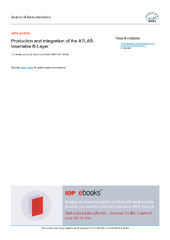Production and integration of the ATLAS Insertable B-Layer
Abbott, Brad; Albert, Justin B.; Alberti, Fabrizio A.; Alex, Markus; Alimonti, Gianluca; Alkire, Steven; Allport, Philip P.; Altenheiner, Silke; Ancu, Lucian Stefan; Anderssen, Eric D.; Dorholt, Ole; Franconi, Laura; Gjersdal, Håvard; Ould-Saada, Farid; Røhne, Ole Myren; Sandaker, Heidi; Kastanas, Alex; Stugu, Bjarne; Andreani, Allesandro; Andreazza, Attilio; Arguin, Jean-Francois; Axen, Bradley; Backhaus, Malte; Balbi, Gabriele; Ballansat, Jacques; Barbero, Marlon B.; Barbier, Gérard; Bassalat, Ahmed; Bates, Richard Laurence; Battaglia, Marco; Baudin, Pierre; Beau, Tristan; Beccherle, Roberto; Bell, Andrew S.; Benoit, Mathieu; Bertsche, Callie; Bertsche, David; Bindi, Marcello; Bomben, Marco; Borri, Marcello; Bortolin, Claudio; Bousson, Nicolas; Boyd, Russell G.; Breugnon, Patrick; Bruni, Graziano; Bruschi, Marco; Buchholz, Peter; Budun, Ercan; Buttar, Craig M.; Clark, Allan G.; ATLAS, Pixel Collaboration
Peer reviewed, Journal article
Published version

Åpne
Permanent lenke
https://hdl.handle.net/1956/20293Utgivelsesdato
2018Metadata
Vis full innførselSamlinger
Originalversjon
https://doi.org/10.1088/1748-0221/13/05/t05008Sammendrag
During the shutdown of the CERN Large Hadron Collider in 2013-2014, an additional pixel layer was installed between the existing Pixel detector of the ATLAS experiment and a new, smaller radius beam pipe. The motivation for this new pixel layer, the Insertable B-Layer (IBL), was to maintain or improve the robustness and performance of the ATLAS tracking system, given the higher instantaneous and integrated luminosities realised following the shutdown. Because of the extreme radiation and collision rate environment, several new radiation-tolerant sensor and electronic technologies were utilised for this layer. This paper reports on the IBL construction and integration prior to its operation in the ATLAS detector.
